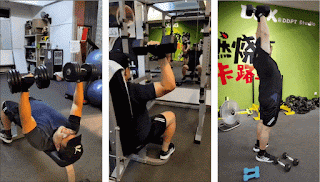The Push and Pull of Strength Training | Complementary Contractions
"Does pushing workouts make you stronger at pulling workouts?"
Hi Richie,
Yes, they do. In fact they compliment each other.
Pushing workouts may work the same muscles as pulling workouts, but their muscle mechanics are slightly different. Pushing is about compression, while pulling is about tension.
But they do help each other. They are more like two sides of the same coin.
So, when we do pushing workouts, we are strengthening our muscles in a way that is complementary to how pulling workouts strengthen them. This means that when we do pulling workouts, we can lift more weight and perform them with better form.
To understand this better, let's think of it like this: When we push something, we are using our muscles to shorten them. This is called concentric contraction. When we pull something, we are using our muscles to lengthen them. This is called eccentric contraction.
For example, bicep curls has both concentric and eccentric contractions:
Concentric and eccentric contractions are both important for strength training. But eccentric contractions are more important for building strength than concentric contractions. This is because eccentric contractions cause more muscle damage than concentric contractions. And muscle damage is what leads to muscle growth.
Concentric and eccentric contractions complement each other in various ways, and incorporating both types of muscle actions into your training regimen can lead to comprehensive muscle development and functional fitness. Here's how they complement each other:
- Complete Range of Motion: Concentric contractions involve muscle shortening, while eccentric contractions involve muscle lengthening. By incorporating both, you work through a complete range of motion, ensuring that your muscles are strong and functional at different points in the movement.
- Muscle Activation: Both concentric and eccentric contractions activate different muscle fibers. Concentric contractions typically involve the activation of fast-twitch muscle fibers, which are important for power and strength. On the other hand, eccentric contractions often engage slow-twitch muscle fibers, contributing to endurance and control.
- Functional Movement Patterns: Many daily activities and sports require a combination of concentric and eccentric contractions. By training both types of contractions, you enhance your ability to perform functional movements efficiently and reduce the risk of injury.
- Muscle Stability: Eccentric contractions play a crucial role in muscle stability. For example, during a squat, the descent phase involves eccentric contractions, providing control and stability to the movement. This is essential for maintaining proper form and preventing injury.
- Muscle Adaptation: The combination of concentric and eccentric contractions contributes to the adaptation and growth of muscle tissue. The microscopic damage caused by eccentric contractions is repaired during the recovery process, leading to stronger and more resilient muscles.
- Power and Control: Concentric contractions are essential for generating power and explosiveness, while eccentric contractions provide control and deceleration. The ability to control and decelerate movements is critical for injury prevention, especially in activities that involve sudden stops or changes in direction.
- Enhanced Performance: Training both concentric and eccentric contractions can lead to improvements in overall athletic performance. This is particularly important in sports and activities that require a combination of strength, speed, and control.
Incorporating a variety of exercises and movement patterns into your training routine, including both concentric and eccentric components, can help you achieve a well-rounded and balanced approach to muscle development and functional fitness.
This is similar to how the Bible tells us that "iron sharpens iron" (Proverbs 27:17). Just as iron sharpens iron, pushing workouts can sharpen our pulling muscles by making them stronger.
I hope this helps. If it does, please
- UPVOTE,
- COMMENT, &
- SHARE.
May you be blessed with the power of David and the wisdom of Solomon.
Faithfully yours,

Comments
Post a Comment